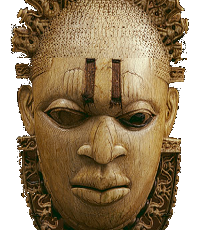East Africa and the Indian Ocean
It is the Bantu migration which will take us from West Africa to the other side of the continent. The Bantu migration is the name given to a massive movement of peoples which took place some time in the first millennium BCE. Leaving a region in what today is eastern Nigeria and Cameroon, people speaking Bantu languages began moving south and eastward, eventually settling in much of central and southern Africa. The migration was a spontaneous movement, not an invasion, but exactly why it took place is not clear. Some scholars suggest that it was due to overpopulation while others cite disease or changes in the climate. The Bantu people knew how to work iron and this allowed them to make better tools and more deadly weapons. The iron tools, in turn, made it possible to cut down trees and open up new fields. The original populations of these parts of Africa were hunters and gatherers, not farmers, and they were either assimilated into the Bantu population or forced to eke out a living in more remote places.
The Bantu migration explains why many people in Africa speak related languages. There are today some 450 Bantu languages and the Bantu speakers make up a third of Africa’s population. All Bantu people share a belief in a supreme God who usually is associated with the sky. The world was not created, they say, but it is eternal. The spirits of people who have died linger on in this world and can influence the lives of the living, at least as long as the dead still are remembered. Many Bantu folktales feature speaking animals — cunning hares, sneaky hyenas, and powerful lions. “Ubuntu” is a shared political principle which African politicians still occasionally invoke in their rhetoric. It is usually translated as “humanity,” or the notion that “I am because we are.”
When the Bantu-speaking migrants eventually arrived on the shores of the Indian Ocean, they came across people and influences from entirely different parts of the world — the Arabian peninsula, Persia, India and beyond. Arab traders had traveled up and down this coast at least since the first millennium of the Common Era and they had established themselves in places like Lamu, Mombasa, and Zanzibar. Merchants from Oman played an important role in this trade too. They transported their goods on ships, known as dhows. [Read more: “A giraffe in Beijing“] This is not to say that the trading ports on the coast were Arabic. Rather, they were cosmopolitan hubs with a culture, and a way of life, which was uniquely their own. The main language spoken here today is Swahili which is a Bantu language mixed with loan-words from Arabic, Hindi and assorted European languages. In fact, Swahili was not originally anyone’s native tongue but was instead a lingua franca used by merchants. In the tenth century, a sultanate was established in Kilwa Kisiwani, in today’s Tanzania. On the beaches of Kilwa one can still find shards of pottery originating in India and China.
A state which benefited greatly from the trade conducted across the Indian Ocean was the Kingdom of Zimbabwe, 1220-1450. Although its capital, Great Zimbabwe, was located inland, on the savanna, it was connected to the sea through well-traveled trade routes and also by the Limpopo River which flows from today’s Botswana to Mozambique. There are some two hundred trading-posts — smaller “zimbabwes” — scattered between Great Zimbabwe and the coast. Not all that much is known about the Zimbabwe Kingdom, but the ruins of the capital leave no doubt regarding its power and wealth. Here too there are abundant indications of a connection to lands all around the Indian Ocean. Archaeologists have found Chinese ceramics in the ruins of Great Zimbabwe, but also coins from Arabia and glass beads from India.
Further north, in the mountains of what today is Uganda, we find Bunyoro and Buganda, two kingdoms that were rivals from the thirteenth century well into the nineteenth. The traditional economy here revolved around big game hunting, but they were making money from trade too. And just as in West Africa, salt was a key commodity. To this day both Bunyoro and Buganda have royal families which take court ceremony very seriously indeed.



